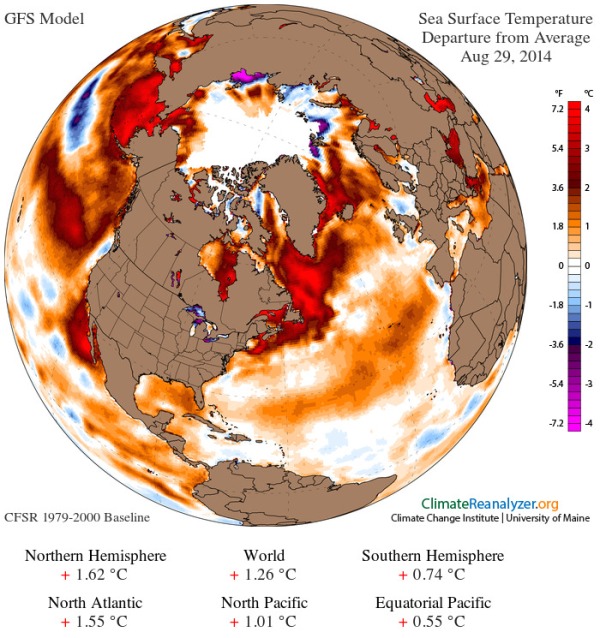The land of ice is being transformed into the land of fire.
Greenhouse gas emissions are forcing the air to rapidly warm (half a degree Celsius each decade in some places). Frozen lands are thawing, liberating billions of tons of soil carbon as an ignition source for wildfires. And methane bubbling up from lakes, bogs, and wet zones in the soil itself provides yet more tinder for a rapidly developing Arctic fire trap.
(What the hell is wrong with this picture? Here we have a bog fire burning away in Saskatchewan, Canada on July 1st, 2015. The bright white color of the smoke is indicative of water vapor mixing in. Due to permafrost thaw, both bogs and related themokarst lakes have been emitting higher and higher volumes of methane over recent years. Methane that could well serve as a volatile fuel for fire ignition over wetlands like the one shown above. Image source: Saskatchewan Ministry of Environment.)
It’s a situation that gained explosive intensity this year as global temperatures hit new all-time record highs and as an obnoxiously persistent ridge in the Jet Stream delivered extreme heat to Alaska and Western Canada. As of today the 652 fires in Alaska alone had burned an unprecedented 3.5 million acres. That’s 3.4 million acres burned since June 18th and more than a million acres ahead of the previous record burn year of 2004. Across the border in Canada, an outrageous 4,672 wildfires had put another 6.6 million acres to the flame — double the five year average rate and nearly three times the 25 year average rate.
Wildfires in Canada now are so intense and widespread that the Canadian armed forces have deployed 1,400 personnel to support in a firefighting effort that has drawn resources from as far away as New Zealand. Earlier this week, the fires forced evacuation of more than 13,000 people in Saskatchewan Province alone. Smoke from the fires combined over the past week to form choking clouds that painted the skies milky-white from Alaska to Canada to the Northern and Central US. Smoke and poor air warnings were issued as far away as Denver Colorado, 1,000 miles to the south of Canada’s blazes. Further to the north and west, a massive smoke plume blotted out the sun over a broad region west of Seattle and Vancouver:
(Smoke cloud blots out the sun for massive region of the Pacific Northwest on July 5th. Image source: Rapid Response.)
Over the next few days, rains are expected to aid in what is now a massive fire suppression effort ongoing throughout Canada. However, rains have also brought with them an inordinate number of lightning strikes this year. And, contrary to some ill-informed statements in the mainstream press during the past couple of weeks hinting that people were the primary ignition source, lightning-initiated fires have been responsible for 99 percent of the acres burned in Alaska alone (information on acres burned by cause for Canada fires was not available in the CIFFC SITREP). In addition, fires have also shown an uncanny resiliency to rainfall — continuing to burn at a very rapid rate (250,000 acres in just the past day) despite widespread storms continuing to flood in from the Gulf of Alaska.
All these massive fires are burning through tree, scrub and bog. But, more importantly, they are penetrating the insulating layer of soil and contacting the thawing permafrost underneath. This soil-breaking fire mechanism is further exposing and accelerating the release of soil-locked carbon. It is also setting up situations where fires can burn in a thawed permafrost understory for additional days, weeks and months.
(Summer is not typically the time of year for substantial methane spikes. But we see them Tuesday in conjunction with increased rainfall, wildfires and thunderstorms throughout the Arctic. Image source: OSPO/METOP.)
We can see a hint of this ominous additional carbon release in the weekly methane readings which this Tuesday hit a peak value of 2525 parts per billion (596 mb) and an atmospheric mean of 1827 parts per billion (496 mb) in NOAA’s METOP measure. Meanwhile, CO2 spikes in the range of 410 to 420 ppm are also widespread throughout the Arctic. Indications that the intense fires are dumping a serious amount of carbon into the local and regional atmosphere .
With billions and billions of tons of carbon stored in the Arctic alone over the past 3-15 million years, we really don’t want to be rapidly warming the Arctic environment as we are. As we can see with this year’s record wildfires we’re actively tossing matches into what amounts to a carbon powder keg. So it’s just maniacally insane that Canada’s government is still planning an all-out production of Tar Sands that will make the already dangerous heat and fire conditions for Canada’s people worse and worse.
Links:
Saskatchewan Ministry of Environment
Alaska Interagency Coordination Center
Thousands Flee Homes in Saskatchewan
Massive Smoke Plume From Canada’s Wildfires
Hat Tip to Colorado Bob
Hat Tip to Andy in San Diego
Hat Tip to DT Lange

























